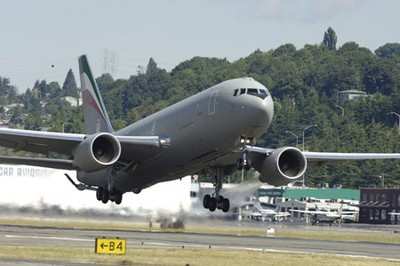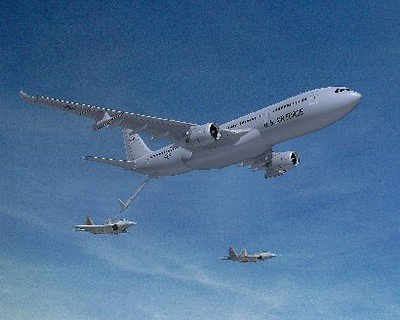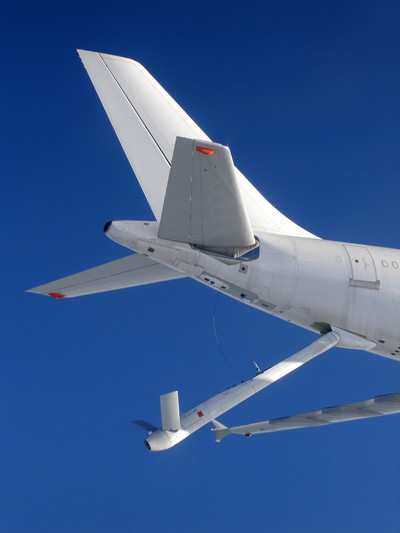Says USAF Evaluation Found KC-767 More Capable, Survivable
The war of words over the US Air Force's selection of the
Northrop/EADS KC-45A refueling tanker over a similiar offering from
Boeing continues to rage, as Boeing once again took to the media
Thursday with reasons why the American planemaker thinks it should
have won.

But Boeing says not to take its word for it... but rather the US
Air Force, whose evaluators found the KC-767 Advanced Tanker
offered more mission capability, and has a better chance of
surviving combat, than the larger Northrop-EADS tanker.
"The fact that the Air Force gave Boeing the highest possible
rating in mission capability and cited the KC-767 Advanced Tanker
as having three times more strengths than the Northrop-EADS tanker
in this most important category further highlights the
inconsistencies in the selection process," said Mark McGraw, vice
president and program manager for Boeing Tanker Programs. "As for
protecting flight crews on the most dangerous missions, the Air
Force evaluated Boeing's tanker as much more survivable than the
Northrop-EADS tanker."

As ANN reported, on February
29 the Air Force selected Northrop/EADS' Airbus A330 derivative
over Boeing's KC-767. Boeing subsequently asked the Government
Accountability Office (GAO) to review the decision, alleging
numerous irregularities and a flawed process that included making
unstated changes to the bid requirements during the competition
that provided Northrop/EADS with an unfair competitive
advantage.
"Despite the changes made in favor of the KC-30 in the area of
mission capability, the evaluation was clear in its assessment,"
McGraw said. "The Air Force identified 98 strengths and only one
weakness with the KC-767, while they pinpointed 30 strengths and
five weaknesses for the KC-30, including four weaknesses in aerial
refueling."
Boeing says the Air Force gave the KC-767 high marks in aerial
refueling. Evaluators cited the ability of the KC-767 to refuel the
V-22 Osprey, which the KC-30 was evaluated as not being able to do.
They cited the smaller KC-767's better maneuverability while flying
heavily loaded into a refueling zone, and they said its refueling
flight deck displays and communications systems were better than
the KC-30's.
Evaluators also found three weaknesses in Northrop/EADS' boom
design and an additional weakness in their ability to be a receiver
due to the lighting of their receptacle, according to Boeing.
In contrast, the Air Force said the KC-767 met or exceeded all
key performance parameters in the mission capability requirements
evaluation. Among some of the other key strengths: aeromedical
evacuation, enhanced navigation system, better use of airport ramp
space, better cockpit displays and communications systems, and more
likely to integrate into operational use faster with new equipment
and future growth.

"Also of significant concern for us is the fact that the Air
Force settled for a plane that is ultimately less survivable for
flight crews performing their vital missions in war zones," McGraw
said. "In providing technology and features that can keep the
airplane more survivable for the men and women flying them, the Air
Force determined that the KC-30 is less survivable than the
KC-767."
The Air Force found that in the critical area of combat
survivability, the Boeing tanker had nearly five times as many
strengths as Northrop's. The Air Force said Boeing's strengths
totaled 24 and gave just five for Northrop-EADS.
"The superiority of the KC-767 in the critical area of
survivability compared with the corresponding 'weakness' of the
Northrop/EADS plane should give warfighters and American taxpayers
alike cause for concern as the GAO continues their review," McGraw
added.

And speaking of that review... on Thursday, Northrop Grumman
celebrated Boeing's decision to trim its original protest before
the GAO down to a few more critical elements, a move Northrop said
made up for the fact the GAO tossed out its motion, as well as one
by the US Air Force, calling for the dismissal of Boeing's
complaint.
"Boeing's decision to abandon the public relations rhetoric
contained in its original protest filings is in keeping with our
motion," said Belote on Thursday.
Hmmm... maybe not so much?
 ANN's Daily Aero-Term (05.07.25): Terminal Radar Service Area
ANN's Daily Aero-Term (05.07.25): Terminal Radar Service Area ANN's Daily Aero-Linx (05.07.25)
ANN's Daily Aero-Linx (05.07.25) Classic Aero-TV: Anousheh Ansari -- The Woman Behind The Prize
Classic Aero-TV: Anousheh Ansari -- The Woman Behind The Prize NTSB Prelim: Bell 206B
NTSB Prelim: Bell 206B Airborne-NextGen 05.06.25: AF Uncrewed Fighters, Drones v Planes, Joby Crew Test
Airborne-NextGen 05.06.25: AF Uncrewed Fighters, Drones v Planes, Joby Crew Test






